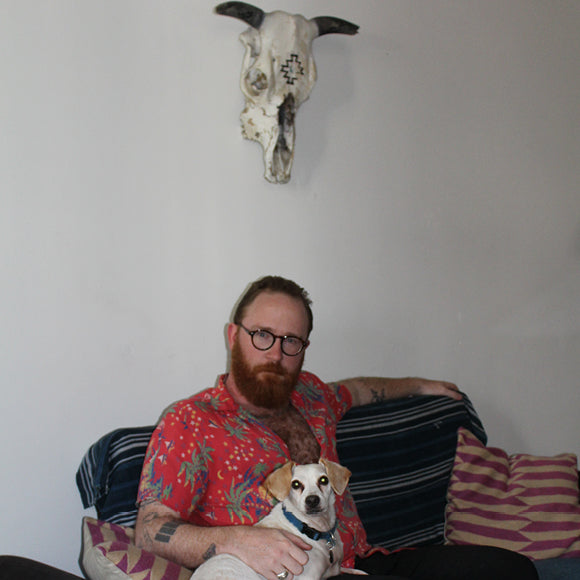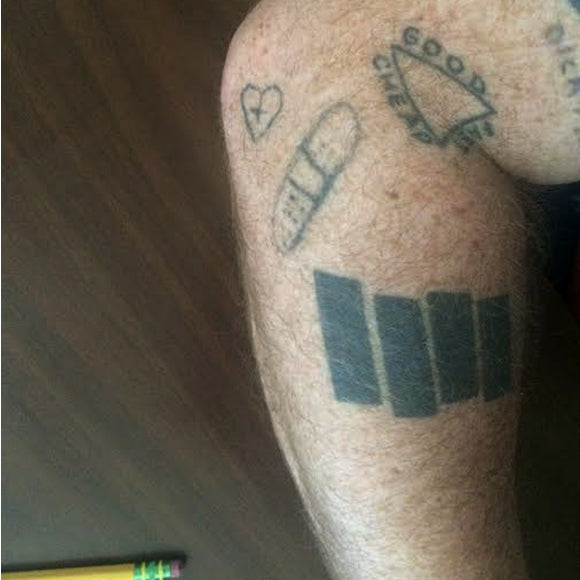FREE SHIPPING AT $70.00
FREE SHIPPING AT $70.00

Sterling Bartlett Interview
October 03, 2016 7 min read
Collaboration and questions with Sterling Bartlett

A. Hey Sterling How’s it Going?
S.B. Pretty Good.
A. So Can you tell us little bit about yourself?
S.B. Yeah, I’m an artist living in Los Angeles, California. I've lived and worked here for about 10 years. I do a lot of illustration, design, and I have a painting practice.
A. Describe a day in the life of Sterling.
S.B. I generally get up about 8 o’clock, take the dog on a hike in the morning. Come back, fix myself some breakfast and get the house in order. I’ll generally work from about 10/11 am to about 6/7 pm. I desperately try to keep it Monday through Friday. That generally doesn’t happen, but if I don’t keep banker hours I’ll go crazy, I’ll work until 3 in the morning so I try keeping it pretty steady. My time is split 50/50 between my painting practice and my design/illustration work.
A. Where did you grow up?
S.B. I was Born in Dumas Texas, which is way up in the panhandle by Oklahoma. I was raised and went to school in San Angelo, which is in west Texas. My dad was in the military so we moved around a lot. I ended up living in Phoenix, Arizona after high School for quite a while. I just had to get the hell out of there, so I eventually moved to LA.
A. When did you first get into the art scene and designing.
S.B. I have been doing design and illustration professionally for about 10 years. I have exclusively been doing freelance work for about 6 years.
A. What was your first job?
S.B. That’s hard to remember, but I think the first job that mattered to me was working for KR3W Denim with a guy name Angel, who I met through a friend.
A. I know of Angel, he is a maniac!
S.B. He’s great... I love that guy.
A. Are you in touch with him?
S.B. I haven’t seen him in a while, but he actually put this (band-aid) tattoo on me, hahaha.

A. How long were you at KR3W Denim?
S.B. I just worked for them freelance. We met through a mutual friend and I did some work for him off and on. I worked a lot with skate, surf and that sort of stuff afterward and it just kind of expanded from there.
A. Have you been doing art shows the whole time or did the focus shift to that later on?
S.B. I used to do a lot of art exhibitions. That kind of took a back seat for a while, but it’s become a much bigger focus for me lately.
A. Why is that?
S.B. There is a fulfillment that comes from working in design and illustration that is fantastic, but you know it's just something else when you can come up with an image in your head and (snaps) someone immediately feels compelled to own it. - it’s just a different beast.
A. How do you come up with ideas and inspiration?
S.B. Well, that’s tough. Speaking to my illustrations, they incorporate text and humorous sayings. That just stems from reading frankly. For the paintings it’s a little bit different. They are much more based on my environment (Los Angeles), the cityscape and the people. That’s a more direct documentation of the things I see.
A. I see on your desk you’re reading the Steve Martin autobiography. Are you a fan of Stand-up? What other comedians do you like?
S.B. I love, love standup comedy. I love the form so much. Off the top of my head I’d list... Richard Prior, and George Carlin. Let’s see, the newer comics, there are so many, it’s so huge right now. There’s Kate Berlant who I think is amazing, Kyle Mooney, Hannibal Buress I love. Louie C.K. I’ve seen a couple times, he’s fantastic. I’m all over the place, I’m just a big fan.
A. Is the imagery you see around LA a large part of what you are doing now?
S.B. Basically, yeah. For so long I’d been working with text and I wanted to move away from that and just be completely visual. So these images are predominantly me walking around, just out walking the dog or taking a hike then stopping and taking photos of something I feel is emblematic of the city.
A. You have gone through a few phases where your focus is on a particular technique. What prompts you to make a change?
S.B. I think exploration is a pretty good way of putting it. You know, I worked in graphite, making these kind of verbal asides with visual accompaniment for so long that I felt like I’d just gotten to the end of that phase of my work. It felt like I did whatever it was I was going to be able to do there. So the medium I’m working in now, (monoprint) allowed me to step away from that and make something totally to the left of it.
A. Can you describe the process of monoprinting.
S.B. What I do is a bastardized version of monoprint. I cut a stencil out of paper, let’s say a palm tree for example. I cut the leafy green portion from the top of the tree out. Then on a separate piece of material, whether it’s another piece of paper or glass, I will apply the paint. I then lay that over the stencil and using a brayer or the back of my hand for pressure, print it onto the piece of paper below the stencil. The stencil then gets removed leaving us with the first part of the tree. I repeat the process using different colors until finished.
A. What I’ve noticed from your Monoprint pieces is the use of bright colors, which is nearly an exact opposite of what you’d been doing. Bringing out a feeling of a fresher more colorful world than from your graphite only pieces.
S.B. Absolutely. I think that was part of change too, going back to what we were talking about before, boredom is something to look out for. Graphite is just one color, -it’s dark gray. (ha) I did that for about 9 years. So I’m trying to go as far away from that as possible! Another thing is when you’re doing monoprint, if you mix too many colors together during the printing process, the pushing of the pigment through of the paper muddies them. I’m almost forced to use the brightest colors possible in order for them to pop once they’ve been printed onto the surface.
A. I would imagine the communication with the viewer is much different from your single color graphite works with text vs the layered monoprint form you are creating now. Is there much difference?
S.B. Absolutely. When I was working with graphite illustrations, it was often an image paired with text. They were basically inside jokes. They were about bringing a certain subset of people together that could understand those jokes in a very specific way. That was a communication between me and a select group of people. The mono-prints, because they are purely visual, are so much more inclusive. A lot more people are on board, if I’m being honest.
A. There seems to have been a recent explosion with the zine art form and that culture. What are your thoughts on its beginning and where it is going.
S.B. In the last 5 or 6 years there has been a resurgence of zine culture. It’s moved some away from punk and into the realm of art. There is certainly an overlap there. I myself, along with a group of friends are involved 3 or 4 times a year in a kind of zine club called “Drawing Party LA”. Where we get together with an old Risograph machine and make a limited number of zines, just kind of for ourselves, just to do it.
A. What is a “Risograph”?
S.B. Basically, a risograph is a Japanese copy machine that puts out a silk screen type of print rather than a photocopy.
A. Looking over some of your collection, do you have a cherished zine?
S.B. From this collection? It’s tough to say. I mean I really like them all, I have a pretty broad zine library. I am proud to say I have Boys Club #1 by Matt Furie, that’s awesome. Adam Villacin and Travis Millard both make a lot of cool zines. Too many more to name.
A. Have you produced your own zine that is publicly available?
S.B. I put out a zine for my last art show called Le Banquet Rousseau. It contained a compilation of essays by my friend Christina Martinez about her experience in Los Angeles juxtaposed against my paintings.
A. Do you remember any single point when art became a part of your life?
S.B. When I was a kid I just always drew. It was always a part of my day-to-day. I can remember drawing at 3 years old. You know, that 3 years and another 32 years of practice, at some point you know it’s what you want to do.
A. Who are some of your favorite artists?
S.B. Oh- that’s so tough. I love Matisse, I just think Matisse is incredible. I love Goya, I think Raymond Pettibone is a hell of a doodler, Mike Kelley, Robert Crumb... So many……..too many to list. I have so many friends that are amazing too. I love Jason Moore's work, Brendon Donnelly, Victor Solomon. I’m very lucky to know some of my favorite artists.
A. We got in touch and licensed some of Robert Crumbs work for T-shirts.
S.B. That’s awesome!
A. Everybody loved it- all the buyers, and all the graphic design guys and artists... but the public didn’t like it at all.
S.B. That’s awful… that’s too bad.
A. They just didn’t want to wear it. His (Robert Crumb's) art isn’t pretty.
S.B. It’s rough and it’s got a lot going on too…
A. That’s a big part of his aesthetic.
S.B. Yeah, the ugly and weird city-scapes are great. So detailed.
A. Lastly, glitter, yea or nay?
S.B. Absolutely yea (ha!) -gets in everything.
A. Thanks Sterling. What are you going to do now?
S.B. I’m going to go grab some lunch
Alright Sterling, thanks and bon appetite!
